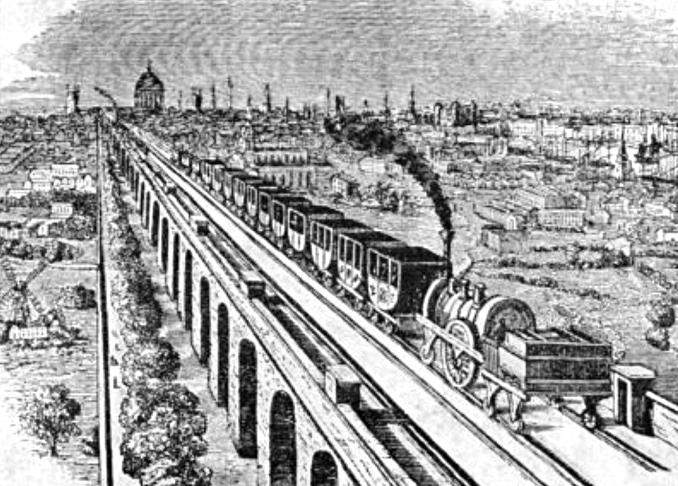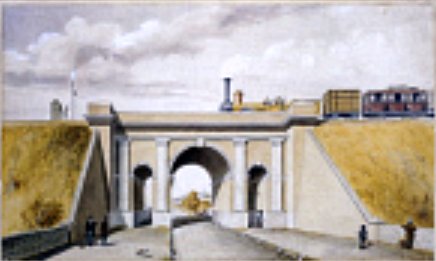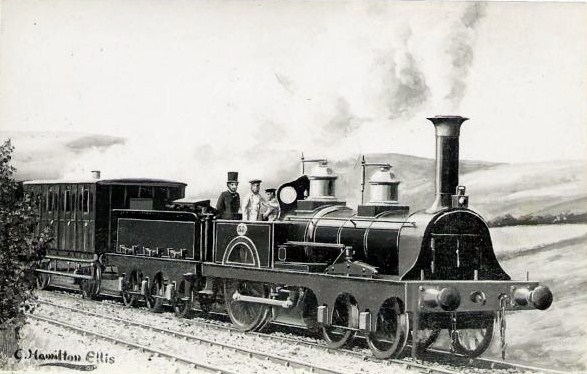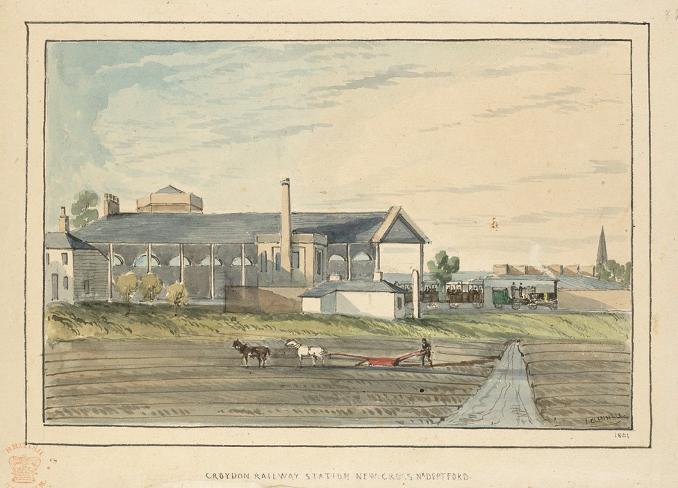
Court Gazette and Fashionable Guide Saturday 06 February 1841
BRIGHTON, Jan. 31
Another melancholy accident occurred on Monday morning at Clayton Tunnel, which is in the line of the London and Brighton Railroad, and about six miles distant from the latter place, on the road leading to Cuckfield.
The accident happened at the shaft No. 6, which was the scene of the dreadful and fatal accident that took place about ten days since by the falling of some of the earth in the tunnel.
The drum, being thus unrestrained, revolved round in the contrary direction, which almost instantly threw it out of its proper position, and it fell on the poor boy, who was crushed in a most dreadful manner. He was immediately taken in a cart to the Sussex County Hospital at Brighton, where it was ascertained that the bone of one of his thighs was severely fractured, and his face and body much lacerated; the injuries were of such a nature that his case was deemed hopeless.
In consequence of this being the fourth accident at the same shaft, the greatest consternation prevailed amongst the men below, who very narrowly escaped, the blocks of stone bounding several feet.
Railway accident on the
London & Croydon Railway
Dartmouth Arms on 5th February 1841
THE COMPLETION LONDON TO BRIGHTON LINE
In March 1841, the Ouse Viaduct was completed and is one of the most elegant examples of early railway architecture, with its 37 tall arches and the four pavilions at each end of the viaduct. There was also an impressive viaduct just outside of Brighton that crosses the London Road.
The three longest tunnels on the line, Merstham, Balcombe and Clayton, were whitewashed and lit by gas flares. Small gas-works were established by the tunnels for this purpose. The lighting of the tunnels was an attempt to reduce the fears of the passengers travelling on the line.
The coal-burning locomotives made it impossible to keep the whitewashed tunnels clean. The passage of the trains also constantly blew out the gas jets that lit the tunnel. The tunnels were also lined with corrugated-iron sheeting to avoid water falling on open third class carriages.
The line between London and Brighton was completed in September 1841. Over 3,500 men and 570 horses were used to build the railway. It had taken three years to build at a total cost of £2,634,059 (£57,262 per mile). The line between London to Haywards Heath was opened on the 12th July 1841. On arriving at Haywards Heath the passengers where conveyed by stage onto Brighton.
The first train entered Brighton station on Tuesday 21st September 1841. On this day the 10.45 am. up train was hauled by two locomotives consisting of nineteen carriages, five private carriages on wagons and horse boxes. It only conveyed 146 passengers. Two compartments in the leading carriage of first class train were reversed for servants in attendance of their employers. The servants were charged second class fares. Initially third class passengers were note carried.
At first, the railway company concentrated on bringing the rich to the coast in first class carriages. It was not long, however, before the company realised that by offering cheap third class tickets, they could increase the numbers of people using their trains. In 1843 the London and Brighton Railway reduced the price of their third class tickets to 3s. 6d. In the six months that followed this reduction in price, 360,000 people arrived in Brighton by train.
Extracted & adapted from
the Railway Magazine
October 1955
SHAREHOLDERS PREVIEW THE BRIGHTON LINE

A party of the shareholders in this undertaking went down the line the morning of Tuesday 6th July as far as Hayward's-heath, about 15 miles distant from Brighton. The journey down to Hayward’s heath was performed in about two hours, including stoppages by the way.
The cuttings are very numerous, and some of them exceedingly deep, the line being in one place flanked on each side by a perpendicular wall of chalk and sand about 90 or 100 feet in height, and the embankments are in some places very lofty.
There are two tunnels, each of which was passed through by the train in about three minutes. By far the most interesting feature on this railway is the large viaduct over the valley of the Ouse, about five or six miles from Cuckfield, the height of which is 150 feet.
As a work of art it is magnificent, and its solidity is quite equal to its grandeur of appearance. The stations on the line are, generally speaking, large and commodious, and the country traversed, for the most part, beautiful and romantic. Some parts of the line are still in a very unfinished state, but we are nevertheless informed that it will be opened the whole distance to Brighton in the month of September.
Judging from the trial of Tuesday, it may be inferred that the entire journey from London-bridge to Brighton may be easily performed in about two hours and a quarter (including stoppages), and perhaps even less.
MORNING ADVERTISERTuesday 13 July 1841
London and Brighton railway.—This Railway Is NOW OPEN from LONDON to HAYWARD’S HEATH, near Cuckfield, for the conveyance of passengers, parcels, horses, and carriages. The trains will run as under:-
DOWN TRAINS
Will leave the Station London-bridge at half-past y and half-past 11 a.m., and at half-post 1 and half-past 5 p.m.
UP TRAINS
Will leave the station at Brighton at 7 and 9 a.m., and half-past 12 and half-past 5 p.m. The first train, on every Monday morning, will leave Brighton at half past 6 o’clock,
SUNDAY TRAINS—DOWN,
Will leave the Station at London-bridge at half-past 8 a.m., and at 2 and a half-past 5 p.m.
SUNDAY TRAINS—UP,
Will leave the Station at Brighton 8 a.m., and at 5 p.m.
Passengers will be conveyed by coach between Haywards Heath and Brighton, and the Fares throughout, from London Brighton, or from Brighton to London, will be, for the First Class Carriages, 15s.; and for the Second Class. 11s. Children, under ten years of age, half price. The whole journey will be completed In four hours. Passengers will not be conveyed from Brighton to Hayward's-Heath, unless proceeding by the trains.
N.B. In order to ensure conveyance between Hayward’s-Heath and Brighton, passengers for the whole distance must book their places on the preceding day, at either of the following offices : Griffin’s, Oxford-street, Green Man and Still; Hatchard's, Piccadilly; 41, Regent-circus; Spread Eagle, Regent-circus; Golden Cross, Charing-Cross: George and Blue Boar, Holborn; Old Bell, Holborn; White Horse, Fetter-lane; Cross Keys, Wood-street; Spread Eagle, Gracechurch-street; or at the Station, London-Bridge; at all of which places parcels may also booked.
Bills, containing the time of departure from, and the fares between the intermediate stations, the terms for conveying horses and carriages, with every other requisite information, may be obtained on application the TerminaI at London-bridge and Brighton; at the respective Booking-offices, or at the Offices of the Company, No. 10, Angel-court,
By order,
Throgmorton-street. July 7. 1841.
THOMAS WOOD Secretary.

PHOTOGRAPHER UNKNOWN
The opening of the Brighton - London railway in 1841, as
seen at Wick viaduct in Brighton
LONDON & BRIGHTON RAILWAY
Accident at Hooley Lane on Sunday 19th September 1841
On the Sunday 19th September, 1841, just a few days before the opening of the line through to Brighton on Tuesday 21st September, 1841, an incident happened which did nothing to dispel such concerns happened very close to the new Red-Hill and Reigate-Road station. News had came through that a train had failed to reach its destination. An hour elapsed, during which tales of multiple casualties circulated. The truth was that one engine with one single carriage containing an inspector and his wife had been sent out to deliver to railway policemen at wayside stations new signal flags for use on the opening day. The special train ran into a line of earth-moving wagons under horse power engaged on final work near Hooley Lane, smashing the trucks and derailing the locomotive. There were no injuries, but the line was blocked with mangled wreckage.
PHOTOGRAPHER UNKNOWN
Railway accidents on the
London & Brighton Railway
from http://www.railwaysarchive.co.uk
Copyhold Cutting on 2nd October 1841 Involving Driver (lead
engine) Charles Goldsmith & his fireman Robert Marshall, Driver
(rear engine) James Jackson & his fireman Robert Field.
SEE SUB PAGE
Patcham Tunnel (South end) Wednesday 6th October 1841
SEE BELOW
Merstham Tunnel Wednesday 27th October 1841
SEE SUB PAGE

LONDON AND BRIGHTON RAILWAY REPORT
PATCHAM TUNNEL
Professor Barlow on the falling in of the Patcham Tunnel
6th October, 1841.
October 15, 1841,
MY LORD, In compliance with your Lordship's request, contained in the instructions
forwarded to me by Mr. Laing. I proceeded on Wednesday, the 6th instant, to Brighton,
having on my way arranged with Mr. Statham, the superintending engineer of the line, to
meet him at the Brighton station onThursday morning, to proceed up the line by a special
engine immediately after the despatch off the 10 h. 45 m. morning train.
This I did accordingly, but as your Lordship has been already informed, on our approaching
the south end of Patcham Tunnel a signal was made to stop, and on inquiring the cause we
were informed of the dangerous condition of the front of that structure, which was obviously
in a falling state. Of course I did not proceed, but returned to Brighton with the engine,
leaving Mr. Statham at the tunnel. In a short time afterwards it appears that the front and a
great part of the wing walls came down.
Before I left the tunnel a person was dispatched to end of it to warn the down train not to
advance, and my arrival at the Brighton Station prevented the dispatch of the 11h. 45m. train.
The Patcham Tunnel is about two miles and a half from the Brighton terminus. Steps were
immediately taken to remove the rubbish, and by the next morning the line was again opened.
Railway accident on the
London & Croydon Railway
Sydenham on 17th December 1841
